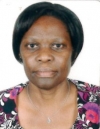Claire Nimusiima
ID: UNCST-2025-R017994
|
Assessing the association Between Disability and Mental Health among older adults: A Secondary Data Analysis of the Health and Wellbeing of Older People - Wave 5 study in Uganda.
REFNo: HS6244ES
Primary Objective
To assess the association between disability and mental health outcomes among older adults in Uganda.
Secondary Objectives
- To determine the prevalence of mental health disorders among older adults with and without disabilities.
- To explore whether any socio-demographic factors modify the association between disability and mental health outcomes.
- To assess whether HIV status confounds the association between disability and mental health outcomes.
|
Not Applicable (N/A), Not Applicable
|
Uganda |
2025-08-08 13:49:11 |
2028-08-08 |
588 |
The WOPS V study population consists of older adults (aged 50 years and above), including both HIV-positive individuals on ART and HIV-negative individuals. In Wave 5, 588 participants were surveyed.
The WOPS study was conducted in 3 districts in Uganda: Masaka, Kalungu, and Wakiso. Participants are recruited from rural, peri-urban, and urban settings, including community health centers and HIV care clinics. The study was coordinated by the MRC/UVRI & LSHTM Uganda Research Unit.
It is this study population that shall be included in the "Assessing the association Between Disability and Mental Health among older adults: A Secondary Data Analysis of the Health and Wellbeing of Older People - Wave 5 study in Uganda" study |
No funding is available for this proposed research as this is going to use already existing dataset. However, the WOPSV study was sponsored by National Institutes of Ageing, USA, through World Health Organization Study on Global Ageing and Adult Health (SAGE) |
Medical and Health Sciences |
Clinical Trial |
Degree Award |

|
David Meya Bisagaya
ID: UNCST-2019-R000837
|
A Phase 2 Novel Antimicrobial Combination Therapy to Treat Tuberculous Meningitis
REFNo: HS5711ES
1. Assess the safety and efficacy of a novel anti-TB combination regimen with greater bactericidal activity than current standard of care (SOC) therapy
|
Kampala, all parishes
Mbarara, all parishes
|
Uganda |
2025-07-18 14:05:06 |
2028-07-18 |
150 |
All adults with TBM meningitis (definite, probable) with HIV, per the uniform TBM case definition. |
Meningitis Foundation |
Medical and Health Sciences |
Clinical Trial |
Non-degree Award |

|
Felix Magala
ID: UNCST-2024-R016043
|
Incidence of Post-Operative Sore Throat Among Patients Undergoing Open Abdominal Surgery: A Randomized Control Trial Comparing Video and Direct Laryngoscopy
REFNo: HS5685ES
To compare the incidence of POST, and recovery from POST following intubation using Video laryngoscopy or Direct laryngoscopy during general anaesthesia among general surgery patients undergoing laparotomy at MRRH
1. To determine the incidence of POST in the first 24 hours following intubation with either Video-laryngoscopy or Direct-laryngoscopy for patients undergoing open abdominal surgery at MRRH
2. To determine the recovery time from POST among patients intubated with Video laryngoscopy compared to Direct-laryngoscopy.
3. To describe the symptoms associated with POST amongst patients intubated for open abdominal surgery
|
Mbarara, Mbarara
|
Uganda |
2025-07-11 18:00:56 |
2028-07-11 |
148 |
Study population
We will recruit surgical patients scheduled for laparotomy (open abdominal surgery, requiring an incision of at least 5cm) at the surgical and emergency ward of MRRH.
Eligibility criteria
We shall include;
• General surgery patients scheduled for laparotomy under general anaesthesia.
• Aged 18 years and above.
• ASA class I to III.
• Mallampati class I to II.
We shall exclude:
• Have had an upper respiratory tract infection or have had an endoscopy or bronchoscopy procedure in the past 2 weeks.
• Have had any ENT, neck or thoracic surgery in past 3 months.
• Those who have symptoms of gastroesophageal reflux disease (GERD).
• And those with history of smoking.
• Those with anatomical abnormality in the neck, head, face.
• Edentulous patient.
• Patients with suspected difficult airway as assessed by the principal investigator.
|
self sponsored |
Medical and Health Sciences |
Clinical Trial |
Degree Award |

|
Daniel Atwine
ID: UNCST-2019-R012948
|
SAFETY AND EFFICACY OF THE PHOTO-KABADA DEVICE AS COMPARED TO DEVICES IN ROUTINE USE IN ADMINISTERING PHOTOTHERAPY FOR BABIES WITH NEONATAL JAUNDICE: AN OPEN-LABEL, RANDOMIZED CONTROLLED CLINICAL TRIAL (MUST-2024-1404).
REFNo: HS5411ES
5) Secondary: To describe the experiences of health workers using the test (Photo-Kabada) and control PT devices and caretakers of children treated with these devices.,4) Secondary: To compare the other safety and efficacy outcomes when babies are treated with Photo-Kabada compared to available phototherapy devices on the neonatal unit of MRRH. ,3) Secondary: To compare the reduction in bilirubin levels per unit time when babies are treated with Photo-Kabada compared to available phototherapy devices on the neonatal unit of MRRH. ,2) Primary: To compare the efficacy of Photo-Kabada phototherapy machine with existing phototherapy machine at selected hospitals in treating neonates with jaundice.,1) Primary: To compare the safety of Photo-Kabada phototherapy machine with existing phototherapy machine at selected hospitals in treating neonates with jaundice.,
|
Mbarara, Nyamitanga
|
Uganda |
2025-07-10 11:09:52 |
2028-07-10 |
30 |
neonates less than 28 days old. Both male and female. |
Villgro Africa |
Medical and Health Sciences |
Clinical Trial |
Non-degree Award |

|
Esther Cathlyn Atukunda
ID: UNCST-2022-R009265
|
Evaluating Healthy Families PrEP: an intervention to promote PrEP use during periconception, pregnancy and postpartum periods for women in rural Uganda
REFNo: HS6117ES
1. Adapt Healthy Families-PrEP (HF-PrEP) to community clinics in Mbarara and Sheema Districts, Uganda to include postpartum women guided by our conceptual framework and the Consolidated Framework for Implementation Research (CFIR
2. Test Healthy Families-PrEP intervention effectiveness in a cluster-randomized control trial in Ugandan community health centers (HCs)
3. Determine incremental cost-per-person participating in Healthy Families-PrEP and estimate cost-effectiveness per incident HIV infection averted among women and their infants.
|
Mbarara, All parishes
Sheema, All parishes
|
Uganda |
2025-07-09 16:14:46 |
2028-07-09 |
approximately 700 women |
There will be two groups of participants engaged for these studies:
1) women ages 18-45 years, in periconception, pregnant, and postpartum periods seeking health services from the community health centers
2) healthcare providers, administrators, and Ministry of Health officials
|
National Institute of Health |
Medical and Health Sciences |
Clinical Trial |
Non-degree Award |

|
Laura Nsangi Joan
ID: UNCST-2025-R016715
|
ValgaNciclovIR for CMV Viraemia in AdvaNced HIV diseAse
REFNo: HS6040ES
The primary objective is to determine if valganciclovir is safe and efficacious in reducing CMV viraemia amongst hospitalised adults with advanced HIV disease and CMV viraemia.
Secondary objectives are to determine the effect of valganciclovir on mortality, to study its pharmacokinetics and explore the immunological response of patients with CMV viraemia before and after treatment with valganciclovir.
|
Kampala, Mulago
|
Uganda |
2025-07-04 14:08:02 |
2028-07-04 |
150 |
Adults and adolescents (≥ 15 years) diagnosed with advanced HIV disease and CMV viraemia, with a CD4 count ≤ 100 cells/μL and CMV viral load >500 IU/mL. |
Wits Health Consortium |
Medical and Health Sciences |
Clinical Trial |
Non-degree Award |

|
Sam Ononge
ID: UNCST-2020-R000328
|
A CLINICAL TRIAL TO EVALUATE THE PERFORMANCE AND SAFETY OFTHE WEKEBERE SYSTEM FOR MONITORING FETAL WELLBEING DURING LABOUR
REFNo: HS3407ES
The overall objective of this study is to demonstrate safety and performance of wekebere fetal monitoring system.
Specific Objectives
To determine accuracy of wekebere fetal monitoring in comparison with gold standard. To determine the safety of wekebere system
To determine’ uterine contractions
|
Kampala, Kawempe
|
Uganda |
2025-06-30 9:35:11 |
2028-06-30 |
120 |
The study population will consist of the following inclusion criteria: i.Female age between: 18-50
ii.Gestational age >36 + 0 weeks iii.Singleton pregnancy
iv.Early labor (cervical dilatation of <6cm)
v.Sign informed consent |
Villgro Africa |
Medical and Health Sciences |
Clinical Trial |
Non-degree Award |

|
Peter Elyanu James
ID: UNCST-2021-R013210
|
OPTIMAH Study: OPTImizing Malaria And HIV treatment in a shifting landscape in Africa
REFNo: HS6165ES
PRIMARY OBJECTIVES
1. Assess the impact of HIV/DTG on weight gain (BMI) in Ugandan children ages 5 to 17 years of age over two years of follow-up.
2. Assess for PK drug-drug interactions between the two most widely used ACTs
(AL or AS-AQ) and DTG in longitudinal cohorts of HIV-uninfected children and CLHIV living in a high endemic malaria region (Busia).
3. To assess the 28- and 42-day efficacy of AL and AS-AQ for the treatment of uncomplicated malaria in children with and without HIV in a setting where artemisinin resistance has emerged.
SECONDARY OBJECTIVES
1. To assess the impacts of DTG on changes in body composition, waist circumference, and metabolic derangements over 2-years of longitudinal follow-up.
2. To assess the impact of repeated malaria infection on changes in weight gain in CLHIV on DTG (comparing HIV-infected cohorts in Busia and Kampala).
3. To determine if changes in DTG PK exposure in the presence of repeated courses of ACTs are associated with impacts on virologic control (pharmacodynamics).
4. To assess for the development of dolutegravir-associated resistance mutations over two years of follow-up.
5. To determine if changes in ACT exposure in the presence of daily DTG for HIV treatment are associated with impacts on malaria treatment outcomes.
6. To critically compare the PK exposure of artemether, artesunate, and DHA in the context of the two leading ACTs in Africa and assess for associations between the PK exposure of artemisinin derivatives as drivers of parasitologic outcomes such as parasite clearance rates for artemisinin-sensitive and resistant infections.
7. To assess levels of gametocytemia in children with and without HIV infection and with artemisinin-sensitive and -resistant infections
8. To determine if repeated course of AL and AS-AQ are associated with selection of resistance-associated mutations to the partner drugs and/or the artemisinin component.
9. To identify novel mutations in known and/or putative loci associated with resistance to artemisinins, lumefantrine, and amodiaquine using amplicon-based sequencing and/or other genotyping methods.
10. To assess the exposure of unbound DTG, lumefantrine, and DEAQ and association with clinical outcomes (viral load or parasitemia)
|
Busia, All Parishes
Kampala, Mulago
|
Uganda |
2025-06-26 23:59:42 |
2028-06-26 |
380 |
CLHIV, ages 5-17 years, will be identified from respective registers at Baylor-Uganda (in Kampala) and the Masafu HIV clinic (and nearby clinics) in Busia Uganda. HIV-uninfected children, also ages 5-17 years, will be enrolled from catchment areas at these two sites. Recruitment will be balanced by age and sex. |
The National Institute of Child Health and Human Development |
Medical and Health Sciences |
Clinical Trial |
Non-degree Award |

|
Jolly Kamugisha G.K.
ID: UNCST-2023-R005715
|
Performance and Factors Affecting the Implementation of the Integrated Management of Acute Malnutrition Programme: A Study of Kampala, Mukono, Wakiso and Kayunga Districts
REFNo: HS6084ES
5. To document the lessons learnt and best practices during implementation of the IMAM program in the four target districts during the calendar year 2022 and 2023.,4. To establish factors that affect the utilization of IMAM services in the four target districts.,3. To determine factors influencing treatment outcomes of children with wasting in the four target districts.,2. To determine the performances of the integrated management of acute malnutrition program in the four target districts during the calendar year 2022 and 2023.,1. To identify the communities contributing to a high burden of childhood wasting caseload in health facilities in four target districts (Kampala, Mukono, Wakiso and Kayunga),The overall objective of this study is to assess the nutrition service delivery and factors influencing utilization of the IMAM programme in Kampala, Mukono, Wakiso and Kayunga districts,
|
Kampala,
Mukono,
Wakiso,
Kayunga,
|
Uganda |
2025-06-20 8:41:29 |
2028-06-20 |
Sample size varies by objective as follows: Objective 1: 1440 records; Objectives 3-5: 5 key informants ()KIIs) at policy level; 8 KIIs - district and facility administrators; 7 KIIs for health workers at facility level. |
1) Children aged < 5years with acute malnutrition - both boys and girls (Records review)
2) Caregivers of children treated acute malnutrition (both females and males aged 18+years)
3) Village Health Teams (both males and females adults aged 18+ years)
4) Health workers caring for children with acute malnutrition (Male and females aged 18+ years; District and health facility administrators (male and female aged 18years
5) Policy level stakeholders, both male and female aged 18+ years)
|
UNICEF |
Medical and Health Sciences |
Clinical Trial |
Non-degree Award |

|
Fred Ssewamala
ID: UNCST-2020-R014060
|
Suubi4PrEP: Improving PrEP Access and Adherence Among Adolescent Girls and Young Women in Uganda
REFNo: SS3990ES
Suubi4PrEP will examine the effect of a multilevel intervention, combining HIV risk reduction that incorporates sessions on PrEP, peer supporters with lived experiences to facilitate linkage to and continued care, and economic empowerment components targeting financial barriers associated with PrEP access, PrEP initiation, uptake and adherence among AGYW in Uganda. Study aims are:
Aim 1: Examine the impact of Suubi4PrEP on PrEP initiation (primary outcome); and PrEP adherence (secondary outcome).
Aim 2: Examine the effect of Suubi4PrEP on hypothesized mechanisms of change (financial stability, PrEP stigma, self-efficacy, depressive symptoms, and social support) and intervention mediation.
Aim 3: Use mixed methods to explore multi-level factors that influence PrEP initiation and adherence.
Aim 4: Assess the cost and cost-effectiveness of the interventions.
|
Masaka, Nyendo
Lwengo, Kinoni
Kyotera, Kakuuto
Kalungu, Bukulula
Rakai, Kakuuto
Sembabule, Sembabule TC
Bukomansimbi, Mbiriizi
|
Uganda |
2025-06-20 7:41:25 |
2028-06-20 |
600 |
The target study population for the proposed Suubi4PrEP study is AGYW (15-24 years) living in HIV hotspots in the greater Masaka region of Uganda.
Emancipated minors (below 18 years) will not need parental/caregiver consent. In Uganda, the National Guidelines for Research Involving Humans as Research Participants (NGHRP) define a child as any person below the age of 18. On the other hand, an emancipated minor is defined as an individual below the age of 18 who are pregnant, married, have a child, or are self-sufficient.
Inclusion Criteria. Female between 15-24 years. AGYW will be screened for HIV risk as determined by the national risk screening tool developed by the Uganda National AIDS Control Program, in alignment with national PrEP guidelines. AGYW will be deemed to be at substantial risk, and eligible to participate in the study, if they report at least one of the seven high-risk sexual behaviors on the risk assessment tool.
Exclusion criteria. A participant will be excluded if they are: 1) HIV Positive, 2) unable to understand the study procedures and/or participant rights during the informed consent process, or 3) they are unwilling or unable to commit to completing the study. If the potential participant has emergency needs (e.g., hospitalization), they will be referred for care instead.
Peer Supporters. These will be women who are HIV negative, enrolled and adhering to PrEP. We expect to recruit at least four peer supporters at each of the 20 sites receiving the PS intervention component.
|
National Institute for Mental Health |
Social Science and Humanities |
Clinical Trial |
Non-degree Award |

|
Denis Nansera
ID: UNCST-2024-R004002
|
Improving HIV testing among Children under five in Rural Uganda
REFNo: HS5829ES
The main objective of this study is to develop a traditional healer facilitated paediatric HIV testing program to improve access to paediatric HIV testing. To do this, we will first use qualitative study methods to determine factors that influence HIV testing among paediatric clients of TH and guide adaptation of the TH-facilitated HIV testing program for children. We will then implement a pilot study to evaluate offering paediatric HIV testing at traditional healer locations in southwestern Uganda.
|
|
Uganda |
2025-05-29 17:12:49 |
2028-05-29 |
465 |
Aim 1: Key stakeholders for Aim 1 will be defined as 1) adult caretakers of children ≤5 years old who receive care from TH in Mbarara District; 2) TH who care for more than 15 children under five each month; and 3) paediatric HIV clinicians from surrounding Health Centres III and IV. All participants will be 18 years or older, and able to provide informed consent. HIV clinicians must also have been in a patient-facing position (doctor, nurse, social worker, counsellor) for at least one year at the time of enrolment.
Aim 2: The study population will be ten TH with monthly volume of 15 children five years old or younger, and 200 children 18 months to 5 years of age who receive care from these TH practices in Mbarara District. Inclusion criteria for TH: aged 18 or older, consent to recruitment of children at their practice, agree with goals of the study and associated procedures, and agree to attend all study-related training. Exclusion criteria will be the same as in Aim 1 above. Inclusion criteria for children are: 18 months to 5 years old; have a parent or caregiver who can provide informed consent; not previously tested for HIV in the past three months; and not previously known to be HIV-infected. |
National Institute of Mental Health |
Medical and Health Sciences |
Clinical Trial |
Non-degree Award |

|
Nanyonga Elizabeth Monica
ID: UNCST-2025-R018232
|
srd
REFNo: SIR516ES
GGGGGGGGGGGGGGGGGGGGGGGGGGGG
|
|
Uganda |
2025-05-27 9:30:38 |
2028-05-27 |
AAAAAAAAAAAAAAAAAAAAAAAAAAAAAAAAAAAAAAAAAAAAAAAA |
AAAAAAAAAAAAAAAAAAAAAAAAAAAAAAAAAAAAAAAAAAAAAAAAAAAAAAAAAAA |
AAAAAAAAAAAAAAAAAAAAAAAAAAAAAAAAAA |
Engineering and Technology |
Clinical Trial |
Non-degree Award |

|
Fred Bulamba
ID: UNCST-2020-R014888
|
Rule of THUMB: A multi-centre cluster trial evaluating the implementation of a perioperative care complex intervention to improve outcomes from haemorrhage during and after caesarean section in African hospitals
REFNo: HS5855ES
To evaluate the effect of the trial intervention on patient outcomes relevant to future trials.,To evaluate whether implementation of the ‘Rule of THUMB’ perioperative complex intervention increases risk assessment and improves diagnosis and compliance with proven interventions for haemorrhage during and after caesarean section.,
|
Mbale, Hospital Cell
|
Uganda |
2025-05-14 9:24:07 |
2028-05-14 |
600 |
Any patient who requires a caesarean section |
Department of Anaesthesia and Perioperative Medicine |
Medical and Health Sciences |
Clinical Trial |
Non-degree Award |

|
Mohamed Farah Mohamud
ID: UNCST-2025-R016841
|
EFFECTIVENESS OF INTRAVENOUS PETHIDINE VERSUS INTRAVENOUS TRAMADOL FOR PERIOPERATIVE ANALGESIA IN UTERINE EVACUATION PROCEDURES AT JINJA REGIONAL REFERRAL HOSPITAL
REFNo: HS5960ES
1. To assess the effectiveness of intravenous pethidine versus intravenous tramadol for perioperative analgesia in uterine evacuation procedure at Jinja Regional Referral Hospital
2. To compare the secondary outcomes encountered among women administered with intravenous pethidine versus those with Intravenous Tramadol for perioperative analgesia in uterine evacuation procedures at Jinja Regional Referral Hospital
3. To compare the level of patient satisfaction with intravenous pethidine versus Intravenous tramadol in uterine evacuation procedures at Jinja Regional Referral Hospital
|
Jinja, rippon
|
Somalia |
2025-04-30 7:27:21 |
2028-04-30 |
170 |
t All adult women with an indication for uterine evacuation admitted on gynecology ward of Jinja Regional Referral Hospital |
selfsponser |
Medical and Health Sciences |
Clinical Trial |
Degree Award |

|
Flavia Matovu Kiweewa
ID: UNCST-2021-R013337
|
An Open-label, Single-arm Study to Provide Continued Access to Study Drug to Participants Who Have Completed Pediatric Clinical Studies Involving Gilead HIV Treatments.
REFNo: HS5804ES
The primary objective of this trial is to provide continued access to the study medication received in the parent protocol or switch to bictegravir/emtricitabine/tenofovir alafenamide (B/F/TAF; coformulated; Biktarvy®) for participants who completed a Gilead parent study evaluating medications for HIV treatment.
|
Kampala, kampala
|
Uganda |
2025-04-11 16:20:58 |
2028-04-11 |
This study is not formally powered. The purpose of this study is to provide continued access to the study medication received in the parent study or to provide B/F/TAF to applicable participants who have completed a relevant parent study. Therefore, all participants who are on parent study medication and have completed a Gilead parent study evaluating medications for HIV treatment may be enrolled in this study dependent on eligibility. |
Participants who have completed a parent study and meet all eligibility criteria will be offered the opportunity to roll over to this study and receive the same regimen as in the parent study. Participants will also be allowed to switch to B/F/TAF when they enroll in this study if they meet the additional
eligibility criteria. |
Gilead sciences Inc |
Medical and Health Sciences |
Clinical Trial |
Non-degree Award |

|
Janet Nakigudde
ID: UNCST-2019-R000444
|
TESTING MULTI-LEVEL SCALE-UP STRATEGIES TO IMPLEMENT A SCHOOL-BASED POPULATION APPROACH OF MENTAL HEALTH PREVENTIVE INTERVENTION: UGANDA
REFNo: HS5647ES
General Objective
The overall goal of this study is to address vertical and horizontal scale-up implementation framework gaps in Uganda. This study will test new recommended vertical scale-up and sustainability implementation strategies and study impact and underlying mechanisms when the new scale-up model is applied.
This research will guide the development of evidence-informed theoretical frameworks and processes to effectively institutionalize EBIs in LMICs such as Uganda. To achieve this goal, we will carry out 4 sequential steps (4 aims).
Specific Objectives
1.
To establish a cross-level partnership and strengthen stakeholders/leaders’ advocacy capacity to make evidence-based informed children’s mental health policy and practice decisions and to facilitate the EBI institutionalization through the educations system illustrated in figure 1.
2.
To develop implementation Protocols in collaboration with cross level partners (established in Aim 1) based on a new multilevel train-the-trainer scale-up framework to support the EBI/PD scale-up.
10
3.
Implement the new Protocols for scale-up and test the relative value of additional implementation supports intended to sustain teacher EBI practices through a Hybrid III cRCT.
4.
To explore underlying scale-up and sustainability implementation mechanisms.
|
Arua, Lodonga, Arua Hill
Mityana, Busubizi, Kyanja
Gomba, Kabulasoke, Nakato
Masaka, Ndegeya, Kyanamukaka
Buikwe, Nkokonjeru, Kasenge
Kabale, Bukinda, Nyaruzinga
Bushenyi, Nyakabirizi
Sheema, Nyabubare
Western Region, Burahya
Iganga, Lwawu
Soroti, Kolojjo
Gulu, Awach
|
Uganda |
2025-04-11 16:03:54 |
2028-04-11 |
The study population and sample will consist of approximately 1,594 participants.46 Advocacy Leaders and Education System Leaders, including 10 from the Ministry of Education (MOE)/Ministry of Health (MOH), 12 from Teacher Training Colleges (TTCs), 12 from District Education Offices, and 12 head teachers (one from each school district/region). Additionally, 12 TTCs will be selected based on MOE prioritization and needs, with 96 tutors trained in Evidence-Based Intervention (EBI) implementation (8 per TTC). The study will also include 120 schools that are stratified and randomized, with approximately 1,200 teachers (10-15 per school) and 240 Peer Teacher Trainers (PTTs) selected and trained. |
The study population will consist of participants from diverse backgrounds. The age group of the participants will vary, with Advocacy Leaders and Education System Leaders typically being adults in their 30s and 40s, while teachers, tutors, and Peer Teacher Trainers (PTTs) will range from 20 to 50 years of age. The study will aim for gender balance, with an equal representation of male and female participants. Participants will be drawn from various ethnic groups across Uganda, including, but not limited to, Baganda, Basoga, Banyankole, Bakiga, and other tribal groups, ensuring inclusivity and representation from all regions of Uganda. The study will also reflect the diversity of the Ugandan educational system, capturing perspectives from urban and rural settings, as well as from different educational leadership and teaching roles. |
This study is sponsor by the United States National Institute of Mental Health through a collaboration with New York University, Department of Population Health, New York School of Medicine and Makerere University College of Health Sciences, Department of Psychiatry |
Medical and Health Sciences |
Clinical Trial |
Non-degree Award |

|
FRED TWINOMUGISHA
ID: UNCST-2024-R003414
|
THE ROLE OF INVOLVING PATIENTS IN PROMOTING HAND HYGIENE PRACTICES AMONG HEALTHCARE WORKERS IN MUKONO AND KAGADI DISTRICTS: A MIXED METHODS STUDY
REFNo: HS5449ES
1)To determine the level of knowledge and practice on hand hygiene among patients and health workers in selected healthcare facilities in Mukono and Kagadi districts, Uganda.
2)To explore the barriers and facilitators of involving patients in promoting hand hygiene practices among healthcare workers in selected healthcare facilities in Mukono and Kagadi districts, Uganda.
3)To explore the perceptions of healthcare workers on involving of patients in promoting hand hygiene practices in selected healthcare facilities in Mukono and Kagadi districts, Uganda.
4)To design and evaluate an intervention to improve hand hygiene among health workers.
|
Mukono, All
Kibaale, All
|
Uganda |
2025-04-11 14:30:15 |
2028-04-11 |
OBJECTIVE 1, 1292 |
This study will be conducted within the two districts of Mukono and Kagadi local governments.
Study population: Patients admitted in Medical, Marternal and surgical wards aged 18 years and above.
Tribes, all tribes both male and female. |
PROMISE CONSORTIUM PROJECT IN MAKERERE UNIVERSITY SCHOOL OF PUBLIC HEALTH |
Medical and Health Sciences |
Clinical Trial |
Degree Award |

|
Ouma Simple
ID: UNCST-2021-R012820
|
Harnessing Parental Social Networks to Increase HIV Testing Uptake Among Children of At-Risk Parents in Uganda: A Parallel-Group, Two-Arm Quasi-Experimental Implementation Science Protocol
REFNo: HS5741ES
Objectives:
Main Objective
To Adapt, implement and evaluate maternal SNS to improve access to HIV testing services among children of FSW.
Specific Objectives
1. To adapt SNS that harnesses maternal SN for HIV testing in children of female sex workers
2. To implement the adapted HASHTAG intervention targeting CARP in Gulu City
3. To evaluate the effectiveness and implementation science outcomes of the HASHTAG project
|
Gulu, All Parishes
|
Uganda |
2025-04-11 14:13:08 |
2028-04-11 |
300 |
The target group for Intervention: We shall invite FSW with at least one child aged 0-17 years. For mothers to be categorized as FSW, each must have received money or goods in exchange for sexual services and consciously defined their activities as income-generating. In addition, we shall enrol active FSW who have been conducting sex work during the one year before setting up the cohort. Thus, maternal sex work status will be ascertained using three questions as follows: 1) Have you ever received money or goods in exchange for sexual services? 2) If yes, have you received money or goods in exchange for sexual services in the last year? 3) If yes, do you consider your receipt of money or goods for sexual services as income-generating? Mothers who answered "yes" to all three questions will be considered FSW. Conversely, mothers who answer "no" to either questions 2 or 3 will be considered non-FSW and be eligible to participate if they have been living in the same neighbourhood as the FSW in the past year before setting up the cohort (Attachment 1). We shall enrol only FSW who do not plan to move outside the greater Gulu in the one year following recruitment into the cohort.
The comparator cohort: The comparative cohort will be matched 1:1 and will comprise non-sex working mothers matched on the neighbourhood, maternal age, child age, and child sex. The comparators must have lived in the same neighbourhood as FSW for at least the year before enrolment. Likewise, we shall enrol only non-FSWs who do not plan to move outside the greater Gulu in the one year following recruitment into the cohort.
The children: Much as children of FSW are the direct target of the intervention, we shall not directly involve them as active participants in the cohort. Children of FSW will be randomly selected from both sexes and without stratification. Meanwhile, children of non-FSW will be matched to children on FSW in the neighbourhood, maternal age, child age, and child sex.
|
IPHASA |
Medical and Health Sciences |
Clinical Trial |
Non-degree Award |

|
Maxensia owor
ID: UNCST-2021-R014003
|
An open-label randomised controlled trial comparing novel combination and currently used antibiotic regimens for the empiric treatment of neonatal sepsis with a run-in confirmatory pharmacokinetic phase: NeoSep1
REFNo: HS5639ES
In Part 2, a secondary objective is to provide a ranking of clinically relevant antibiotic regimens based on other efficacy and safety secondary outcomes, as well as on health economic measures and the potential selection of resistance. The trial data will provide data to inform the balance between efficacy, safety, costs (and cost-effectiveness and equity, using health economic analysis) and propensity for resistance selection (based on microbiology tests) that will influence facility-level and national decision-making about adoption of studied regimens, and potential future inclusion in WHO guidelines.,In Part 2, the primary objective is to provide a ranking of eight different clinically relevant antibiotic regimens for first-line empiric and second-line (after lack of response/deterioration) treatment in terms of 28-day mortality as the primary outcome measure. It will flexibly compare these multiple different relevant treatment regimens to enable the trial to be run in sites worldwide with very different background rates of different pathogens, of resistance and patterns of routine clinical care by randomising each participant to locally relevant antibiotic regimens agreed prior to site initiation. The trial will ensure generalisability by focusing inclusion based on clinical symptoms associated with high mortality risk in the NeoOBS study, which have been developed into a novel neonatal sepsis severity score – the NeoSep Severity Score.,
|
Kampala, Kawempe
Kampala, Mulago
|
Uganda |
2025-04-02 9:04:16 |
2028-04-02 |
400 for the MU-JHU site.Approximately 3000 participants across all participating sites. |
Neonates≤28 days of age hospitalised with clinical signs of neonatal sepsis. |
Global Antibiotic Research & Development Partnership (GARDP) |
Medical and Health Sciences |
Clinical Trial |
Non-degree Award |

|
Sylvia Kusemererwa
ID: UNCST-2019-R001717
|
A phase III, multi-center, randomized, placebo-controlled, double-blind
study to assess efficacy and safety of crizanlizumab (5 mg/kg) versus placebo, with or without hydroxyurea/hydroxycarbamide therapy, in adolescent and adult Sickle Cell Disease patients with frequent vaso-occlusive crises
REFNo: HS5607ES
To assess the efficacy and safety of crizanlizumab (5 mg/kg) versus placebo, with or without
hydroxyurea (HU)/hydroxycarbamide (HC) , on VOC rate in Sickle Cell Disease (SCD) patients aged 12 years and older who experience frequent vaso-occlusive crises (VOCs)
Primary Objective
1. To compare the efficacy of 5 mg/kg of crizanlizumab versus placebo, with or without hydroxyurea/hydroxycarbamide, on the annualized rate of VOCs* that are HCP managed (including VOCs leading to management at a health care facility or those via remote consultation) over the planned 52-week treatment period in SCD patients aged 12 years and older with a history of frequent VOCs (4-12 events in 12 months prior to the screening visit).
Secondary Objectives
1. To compare the efficacy of 5 mg/kg of crizanlizumab versus placebo, with or without
hydroxyurea/hydroxycarbamide, on the annualized rate of all VOCs including VOCs that are HCP-managed (including VOCs leading to management at a health care facility or those managed via remote consultation) and VOCs that are self-managed without recommendations from HCP during the event over the planned 52-week treatment period in SCD patients aged 12 years and older with a history of frequent VOCs (4-12 events in the 12 months prior to the screening visit).
2. To evaluate the annualized rate of VOCs by type of management between treatment arms over the planned 52-week treatment period:
VOCs that are HCP-managed at a health care facility
VOCs that are HCP-managed via remote consultation
Page 4 of 18
VOCs that are self-managed without recommendations from HCP during the event
VOCs that are HCP-managed via remote consultation or self-managed without recommendations from HCP during the event
|
Masaka, Masaka
|
Uganda |
2025-04-02 8:58:47 |
2028-04-02 |
20 |
A total of 10-20 participants will be recruited at the MRC/UVRI and LSHTM Uganda Research Unit site. Recruitment will be competitive across sites and countries. Participants will be recruited through referrals from the sickle cell clinic at the Masaka Regional Referral Hospital. The clinic has a total of about 600 patients. The site will recruit participants according to the main study protocol using the inclusion and exclusion criteria stated. They will collect detailed locator information including addresses, telephone contact, and next of kin to facilitate phone and/or physical tracing during the follow-up phase of the study. |
LSHTM |
Medical and Health Sciences |
Clinical Trial |
Non-degree Award |
.jpg)
|
| View |
|
Sort By: |
|
|
|
| |
|











